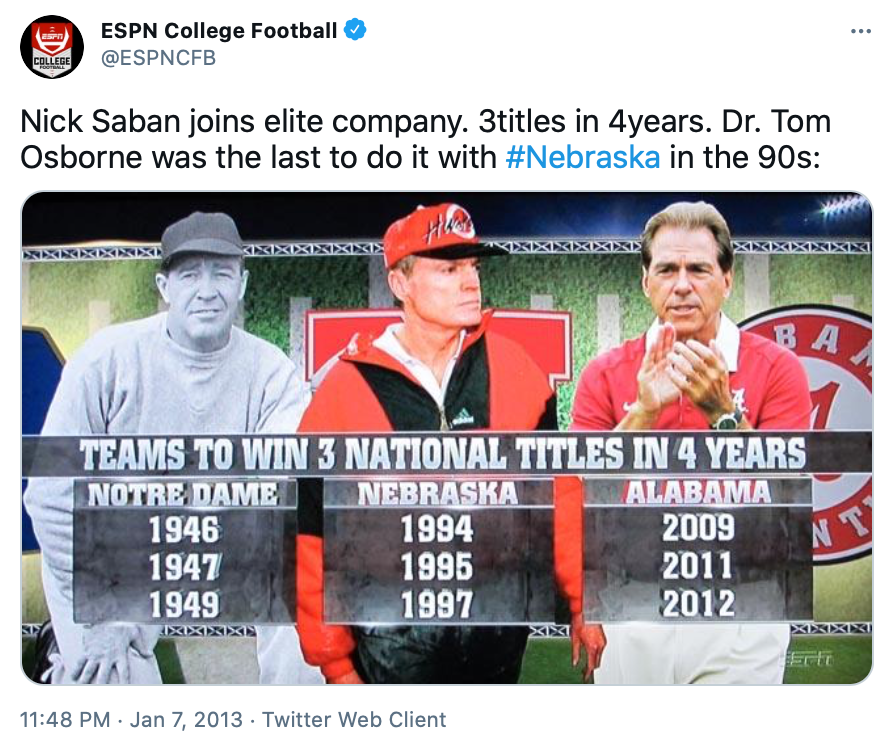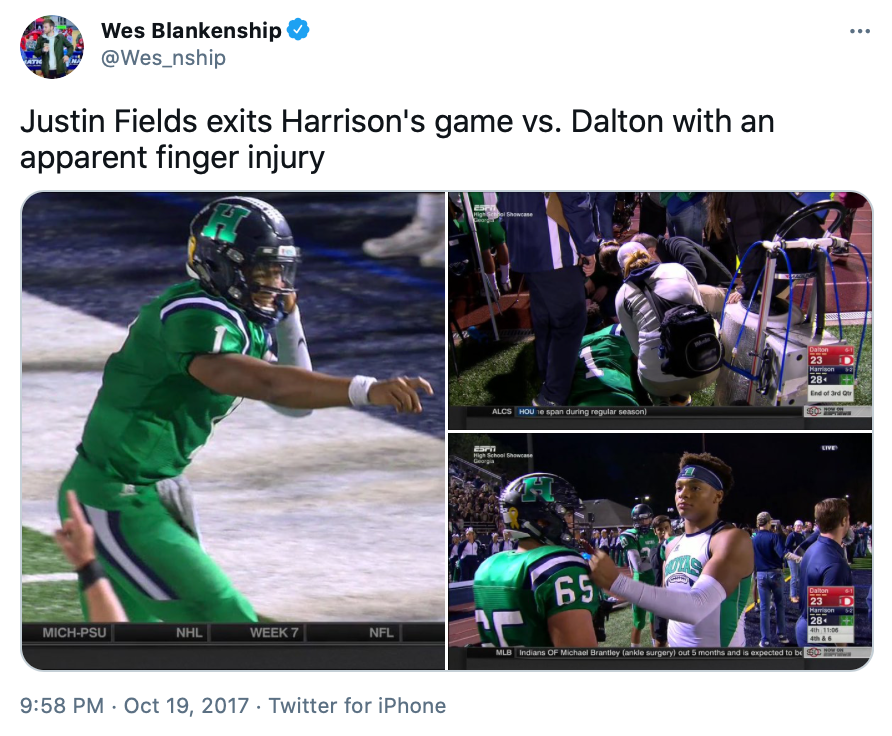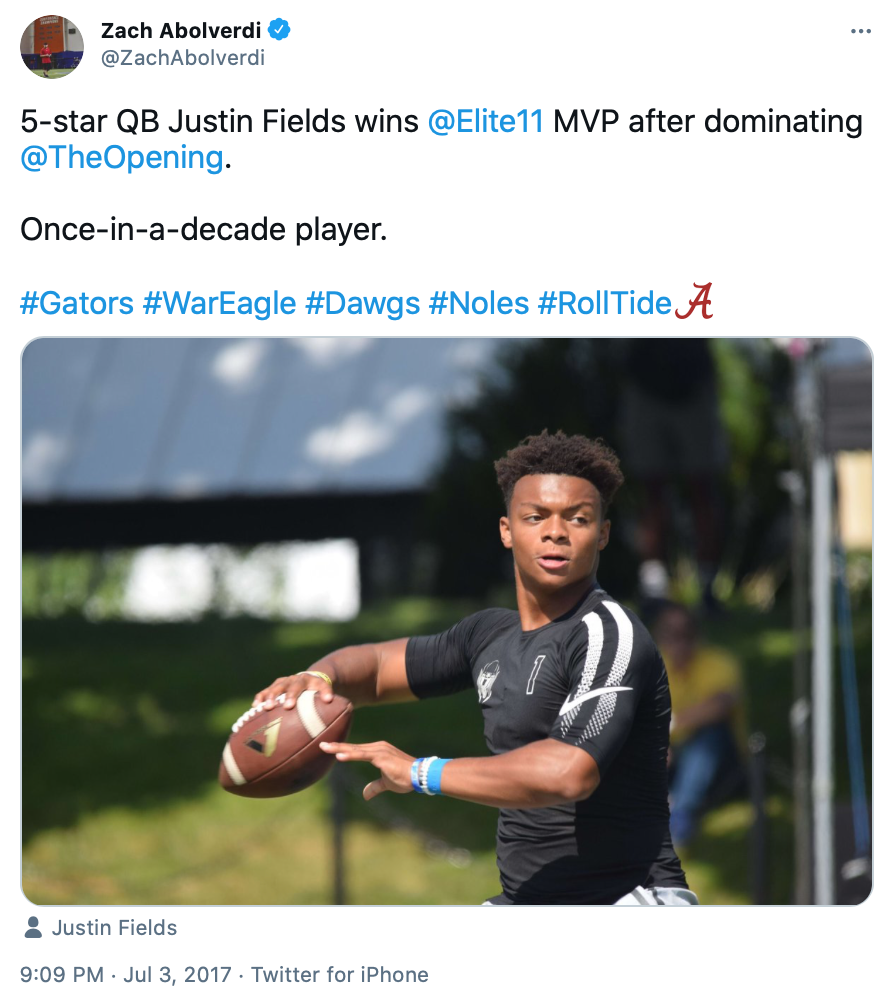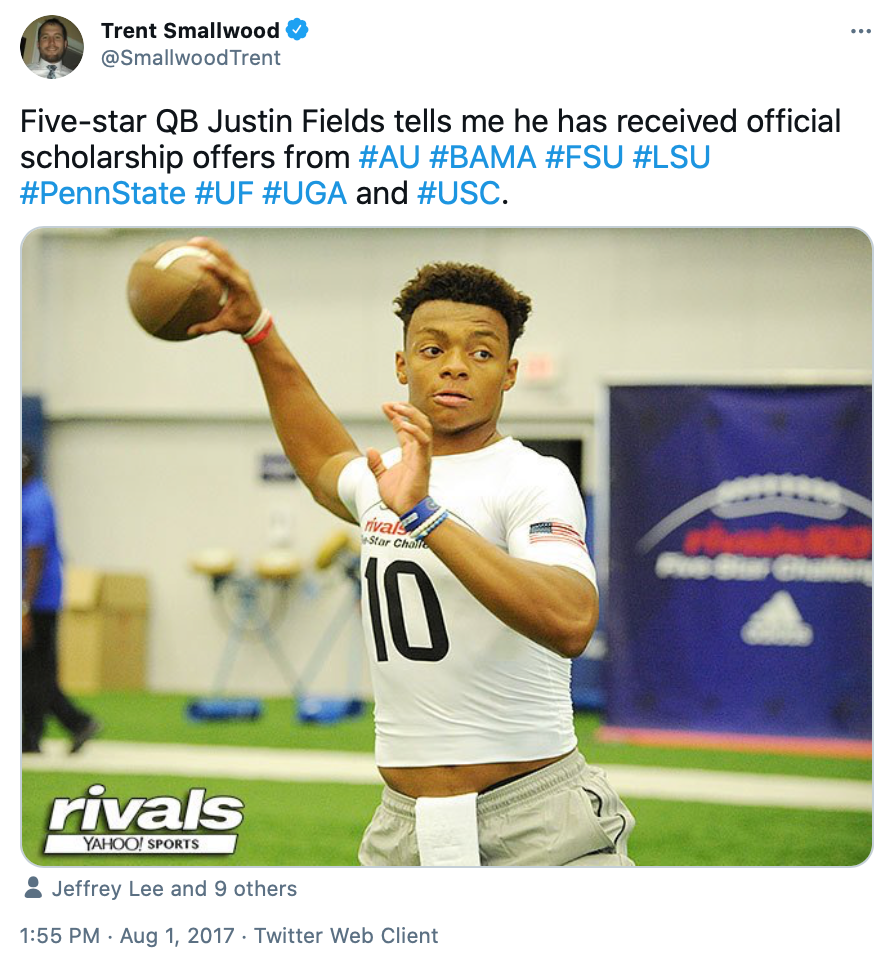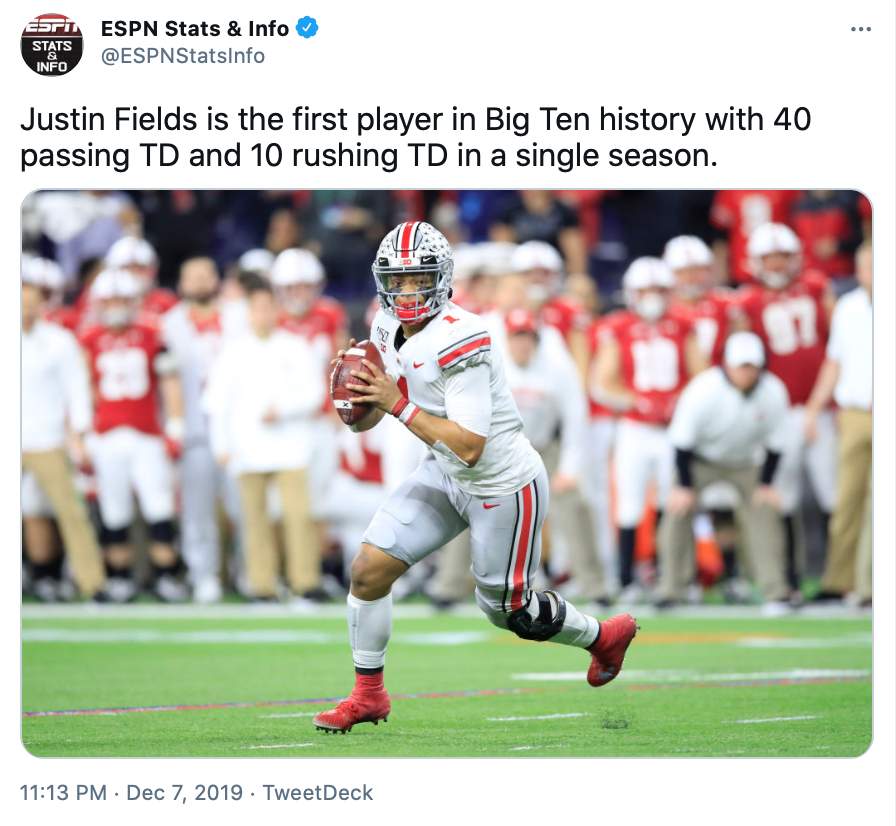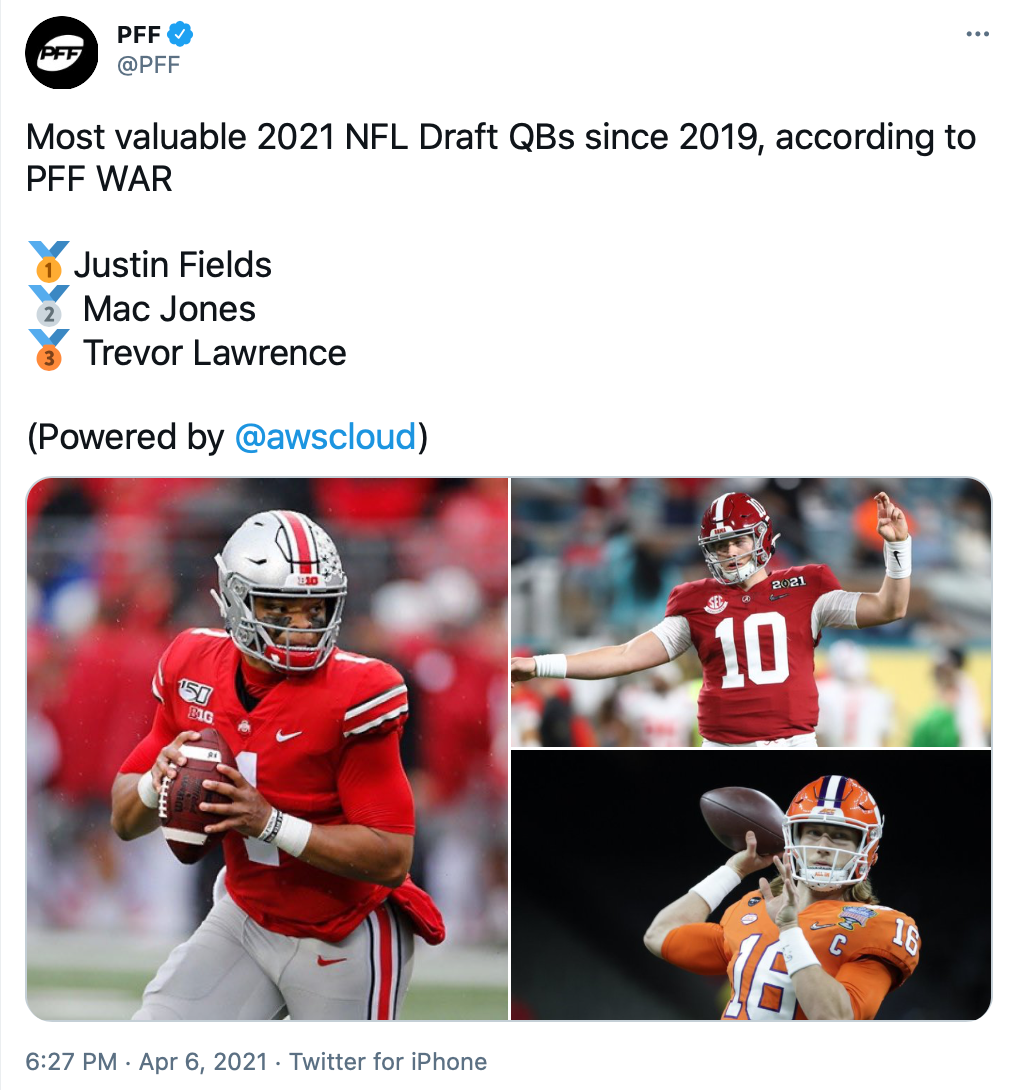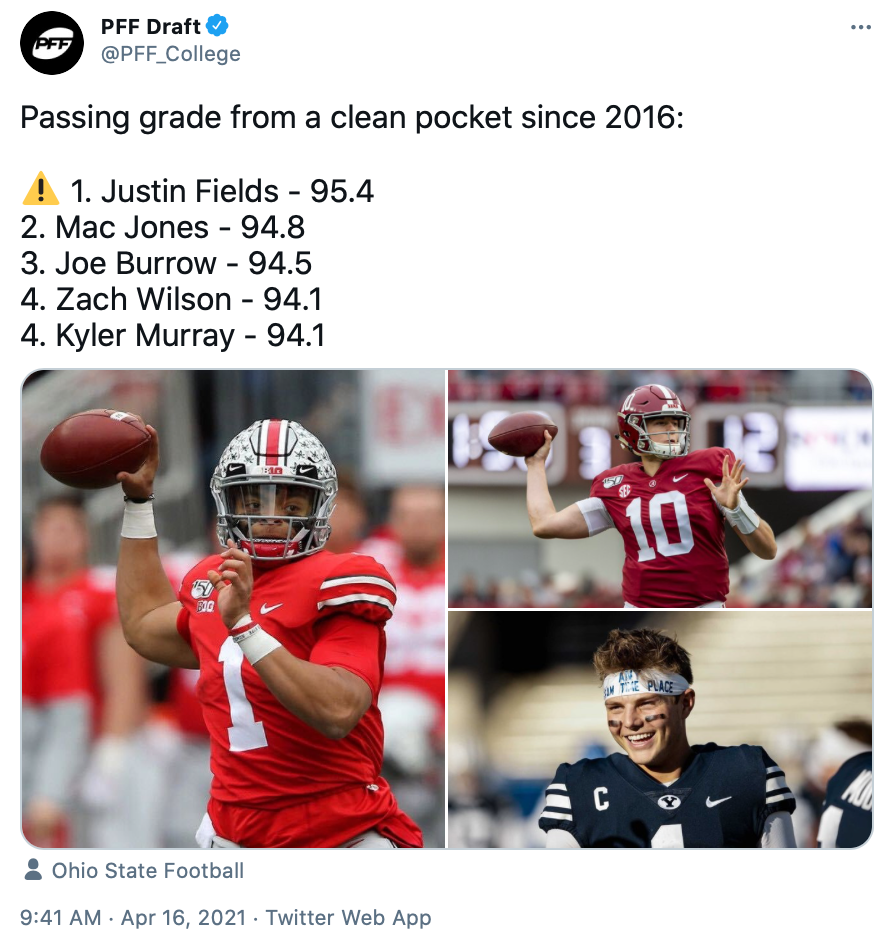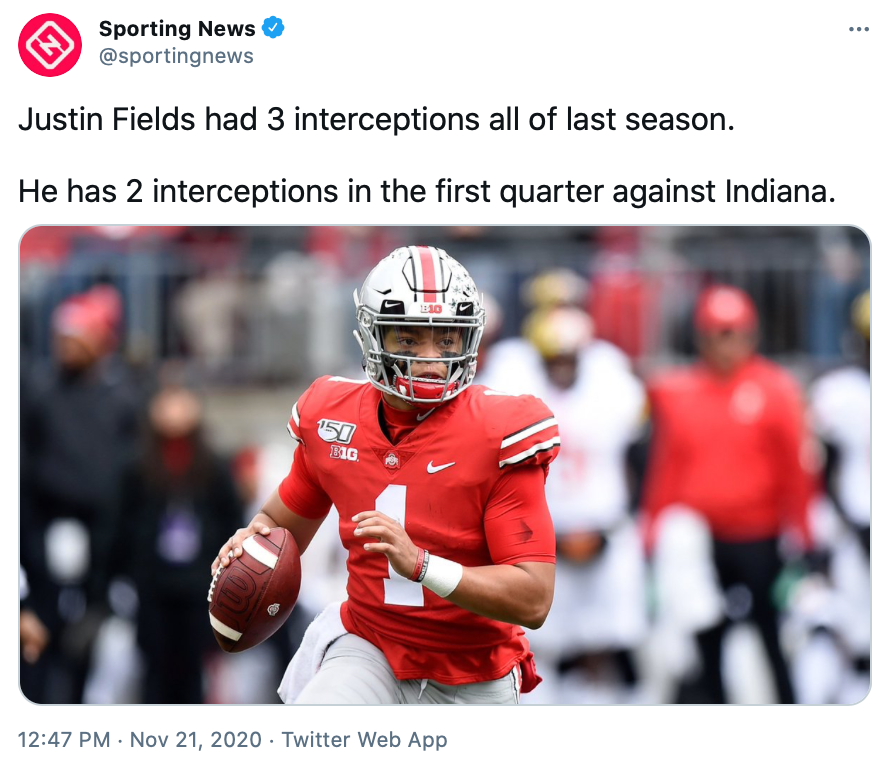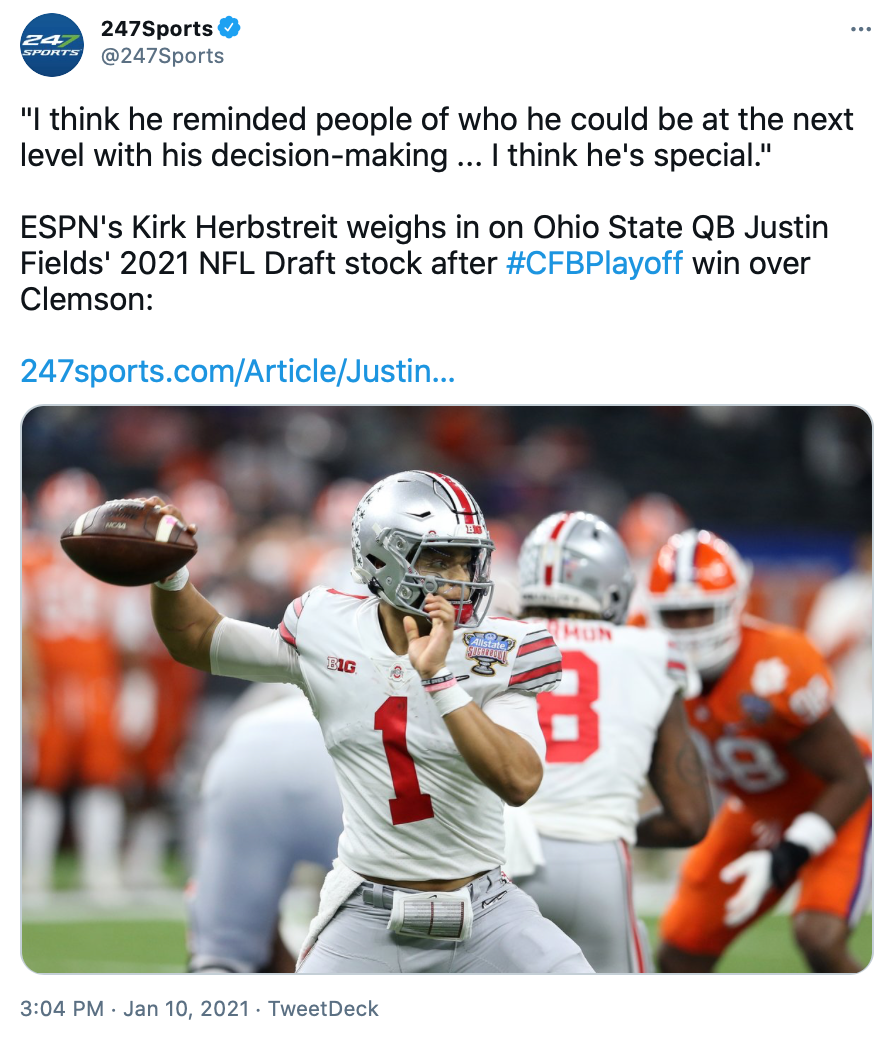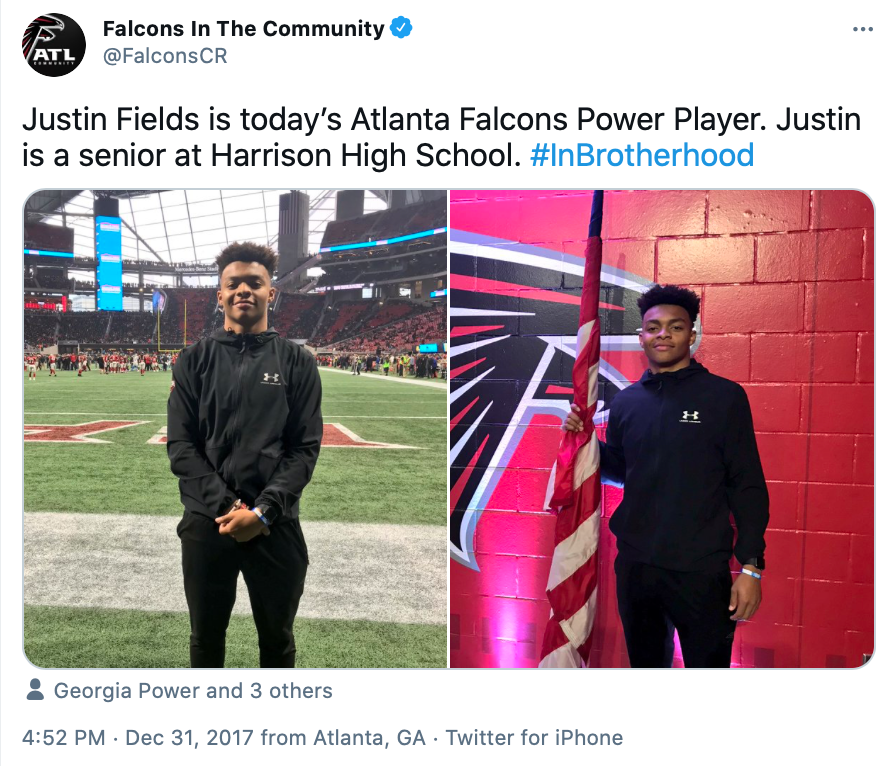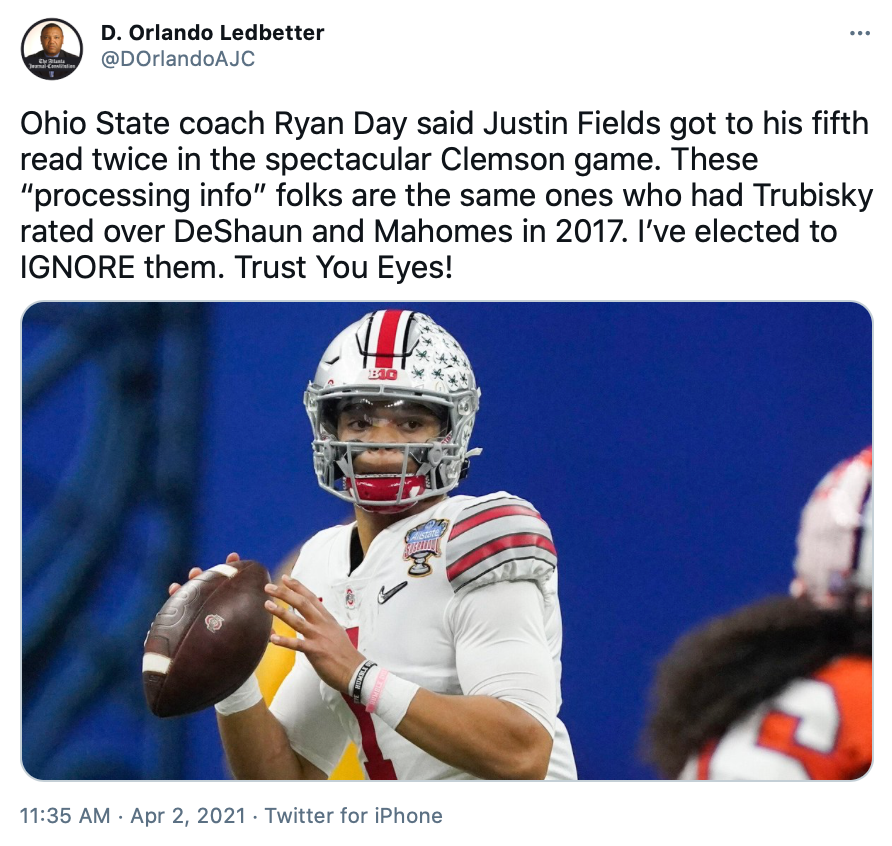Justin Fields
QB | Ohio State Buckeyes | 6-2 3/4 | 227 lbs.
NFL QB Expectations
Over the last three NFL seasons, QBs have been tasked with targeting their receivers on three particular patterns at a higher rate than those sexy Go routes. The most frequent of which is the Out — 18% more than Gos. Not to be confused with the Speed Out, you can distinguish between the two by the squared-off break — a hard cutting 90° angle for the traditional Out. The second most frequent route — 12% more common than Gos — is the Hitch (also referred to as a “Curl,” “Hook,” or “Stop”). Next, we have the Crossing pattern — 11% more — where the receiver will drive toward, cross midfield at various depths. While these three routes may not elicit the same level of viewing excitement as the beloved Gos, the third-level work accomplished by the deep targets are entirely dependent on the underneath patterns keeping secondaries honest. To close out the most important routes required by the NFL QB to master, we have the collection of routes I will refer to as Flatwork (Speed Outs, WR Screens, and Slide routes). These will most often involve Slot WRs and TEs working at a depth within five yards of either flat. These five patterns account for over 75% of the average route profile for NFL QBs.
Evolution of the NFL
Let’s begin with some revelations concerning the NFL of the modern era — the majority of which will be supported by facts, though the final epiphany will not. However, as will be detailed later, the reasoning will be explored to support that belief toward identifying the hypothesis as far more than a conspiracy theory.
We’ll begin with the facts. NFL offenses have undergone a strategic overhaul over the last 10-13 seasons. Most are already aware that many of the schematic inventions first unveiled in the collegiate game have already leaked into the NFL. With so many NFL coaching staffs populated by individuals with previous college coaching experience, we should not be surprised. However, those NCAA blueprints have extended far beyond a leak — the floodgates have opened.
A collection of historical inventions are directly linked to these changes. The first dates back around 100 years with the Option offense (i.e., Single-Wing formation) installed by all-time greats Walter Camp (Yale) and Glenn “Pop” Warner (Carlisle) — with the help of Jim Thorpe, and Knute Rockne (Notre Dame), etc. Around the 1970s, these Option offenses were transformed into the Wishbone and Flexbone variations that would eventually power Tom Osborne’s Nebraska and Barry Switzer’s Oklahoma offenses that thrived during the 1980-90s.
The next evolution incorporated components of the Option with Bill Walsh’s West Coast offense. Bill Snyder made his mark by scheming the Zone-Read into his 1990s Kansas State offenses. After the turn of the century, Rich Rodriguez added those elements into his Spread offenses at West Virginia, and Urban Meyer introduced them in unison with the Shotgun while coaching Bowling Green.
The final piece of the puzzle was provided by Hal Mumme and Mike Leach. Combining the receiver motion adjustments to coverage schemes from the Run-and-Shoot invented by legendary high school coach Glenn “Tiger” Ellison, details from Walsh’s West Coast offense, and LaVell Edwards’ (BYU) pass-heavy offenses were built into their Air Raid formula at Kentucky in 1997. (Though they actually originally invented the Air Raid around 1990 while coaching at Iowa Wesleyan.)
This past season, 22 NFL teams called a pass on at least 60% of offensive snaps, and half of those on at least 65%. It only took a little over 20 years for the NFL to fully incorporate the college design, and at incredible rates during the last three seasons. Between the ever-increasing number of college coaches (i.e., Kliff Kingsbury), QBs (i.e., Patrick Mahomes) bringing along their knowledge of the schemes, the NFL has reinvented itself. It’s also (unsurprisingly) led to drastic alterations on the defensive side in response, but we’ll focus our attention on offense.
The eye-opening alterations include changes to personnel groupings. Over the last 10 seasons, the usage rate of Heavy personnel — defined by the combination of the RB/s and/or TE/s on the field as being greater than two — has declined by 74%, and replaced by the Spread — no more than a total of two RB/s and/or TE/s on the field. When we have seen Heavy personnel on the field over the last three seasons, offenses have run the ball 43% more on average than in the previous 10 years. In fact, passing with Heavy personnel has declined by 78% over the last 10 years! Teams have aligned with their QBs in the Shotgun 67% more over the last three seasons than the previous 10 seasons. Run plays from Shotgun have shot up by 36% over the last three seasons — a direct descendent of the Air Raid. And pass plays from Shotgun have seen a massive 53% spike that has remained steady over the last six seasons.
Since nearly 85% of passing attempts from a Shotgun alignment during 2020 involved at least three WRs on the field, the narrative that Slot WRs hold diminished value to their outside-the-numbers brethren is no longer accurate. The fact that Slot WRs earn, on average, $1.5 million less perseason than Outside WRs is an archaic design based on the data. Another antiquated school of thought surrounds the idea that a lack of Under Center snaps in college as a negative factor in QB potential. Anyone following this doctrine should be notified that the rate of Under Center QB snaps have declined by 81% over the last 10 years! When you do see snaps from Under Center, offenses have used the formation to run the ball 84% more than a decade ago.
Another offensive factor we see increasing in today’s NFL is the usage of Play Action. Teams under the control of Andy Reid (Chiefs), Kyle Shanahan (49ers), Sean McVay (Rams), and Matt Rhule (Panthers) — just to name a few — utilize Play Action on around one-third of all passing attempts. It’s a growing trend that has seen teams increase their usage of Play Action by 62% — 68% more on pass attempts — over the last three seasons than in the 10 years prior. During the last 10 seasons, the number of Play Action Bootlegs has immensely increased, used 83% more over the last two seasons than the eight seasons prior.
Finally, with these alterations to offensive playstyles, the data suggests the future of the NFL will be almost entirely under the control of mobile QBs. We’ve seen a 65% upsurge in QB rushing attempts when forced away from the play design, coinciding with a 50% resulting increase in QB rushing yards, and 58% more byproduct TDs over the last three than in the 10 seasons prior.
Evolution of the NFL War Room
Now that we’ve gone over the forensic data, we come to the factor that has become as much of a reality as any playstyle trend as teams try to fool opponents. These practices can best be described as a form of psychological warfare.
As defined by Merriam-Webster: psychological warfare “denotes any action which is practiced mainly by psychological methods with the aim of evoking a planned psychological reaction in other people.” To put another way, these strategies are used to influence its target audience's reasoning to reinforce attitudes/behaviors that are favorable to the originator's objectives. Mass communication advances — specifically social media — over the last 15 years have led to direct communication with the entire populace, including an indirect link between NFL front offices.
As all parents know a thing or two about, reverse psychology is defined as “a method of getting someone to do what one wants by pretending not to want it or by pretending to want something else.” Recent research shows that the world spends, on average, one-fourth of its online time on social networks, indicating the massive role these media platforms influence the psyche of its users. Some have hypothesized that smartphones have been the ultimate catalyst.
Where could I possibly be going with all of this? Evidence that social media use has led to a probatory persuasion of political beliefs shines a spotlight onto the NFL prospect narratives passed along by trusted insiders — influencers, if you will — on social media platforms. We can definitely all agree these reports from “unnamed” sources play a significant role during the draft process, passing rumors indirectly from team-to-team.
We have more than enough evidence from controlled studies that have been conducted, for example, where, after watching satirical political videos, the participants’ political views were influenced closer to those of host John Oliver. Those same user viewpoints that had just been altered were then instantly reversed upon presentation of social media comments in opposition to Oliver. As much as we want to deny it, our brains are hardwired toward groupthink.
To provide an early example of an NFL team using knowledge of this psychological groupthink “weakness,” look no further than the 2009 draft — only three years after Twitter came online. “Unnamed NFL sources” used the media (Sports Illustrated) to report that Boston College DT B.J. Raji — regarded as the top defensive lineman in the draft class — failed his combine drug test.
A little over two weeks later, the NFL released the official list of failed tests, and Raji’s name was not included. Those sources were, to no one's surprise, never made available. But that doesn’t erase the fact that an attempt was made from within an NFL franchise to pass along false information in order to sink Raji’s draft value for their own gain. The team that perpetrated the ruse knew all along that Raji would have his name cleared but, through that false report, it forced a failed drug test in Raji’s earlier life into the limelight. Raji ended up being drafted by Green Bay at 1.09. One year later, he anchored Dom Capers' 3-4 defense at 0-tech toward securing the Packers’ Super Bowl XLV 31-25 victory over the Steelers.
To be clear, Raji’s was a drastic example of one team’s use of psychological warfare on the rest of the league. We have no way of knowing if the responsible party ultimately benefited from the tactics. And reports of phony drug test failures are not a common occurrence. They simply draw too much attention to information that can be proven inaccurate. But don’t think for a second that these “psyops” have been abandoned as a tactic. Even with the amount of college player analytics available to NFL teams, claims to player inadequacies can still be made that are entirely impossible to refute with numbers. NFL teams employ what amounts to presidential cabinets consisting of expert minds across various disciplines, including psychology. And we can only expect to see the use of such tactics increase in the future.
The Story
Justin Fields’ parents separated when he was very young, but both sides played an active role during his upbringing. His father, Ivant “Pablo” Fields, previously played LB collegiately at Eastern Kentucky. Justin’s father had a second child, Jaiden Fields, with his new wife, JoAnne. Jaiden was a three-time First Team Georgia All-State selection in softball, and the 2018 Class 6A Player of the Year For Harrison High. A year-and-a-half her senior, Justin also attended Harrison. In three seasons as the Hoyas’ starting QB for HC Matt Dickman, Fields never completed less than 67% of his attempts. In addition to 63 combined TD passes to 13 INTs, Fields averaged 1,036 rushing yards, and 14.7 TDs per season. Here are Hudl links to his Junior and Senior seasons, for your perusal.
During his HS development, Fields shared the same offseason QB coach as Trevor Lawrence, Ron Veal. Fields grew up admiring Michael Vick when he played for Justin’s hometown Atlanta Falcons, an interesting tidbit I’ll look into later. Considering his sister’s diamond skills, it’s not surprising Fields also had a promising baseball career as a shortstop and second baseman for Harrison. Fields’ first season as the Hoyas’ starting QB was cut three games short due to a finger injury — the only injury forcing him to miss time of his young career.
Fields’ recruiting blew up after his junior season when scouting outlets universally advanced him up to the top spot among dual-threat QBs in the 2018 recruiting class. He received the universally coveted five-star rating from the prep scouting circuit’s Big-Three: ESPN, 247Sports, and Rivals. Fields chose to decommit from Penn State, ultimately signing with the Georgia Bulldogs due to the outstanding recruiting work of OC Jim Chaney and RB coach Dell McGee. He ended his senior season as the 2017 AP Class 6A Offensive Player of the Year, and AP First Team Georgia All-State. In a group that included Lawrence, Fields also garnered the MVP award at the 2017 Elite 11 QB Competition.
The Attributes
At the Nike-sponsored The Opening Regionals, Fields posted a 4.51-second 40-yard dash time that not only bested all other QB participants, it would fall in the 100th percentile compared to NFL Combine QB testing over the last eight seasons. He added a 4.16 short shuttle (83rd percentile) and 37.5-inch vertical jump (100th percentile). The shuttle is important for testing acceleration and change of direction. The vertical tests a player’s lower body explosiveness. The athletic testing has long been considered of secondary importance in comparison to a QBs college film, passing drills, and individual interviews to convince teams of arm talent, pocket composure, coverage understanding, etc. However, as I’ve already discussed the ever-changing needs in the current NFL, perhaps those primary focuses should be considered alongside the presence of generational athleticism. For example, if we were to build the perfect QB for the modern NFL, it would be the merging of Mahomes’ arm talent, brain, and Vick’s athleticism.
During The Opening recruiting combine attended by Lamar Jackson, he recorded a 40-time of 4.77 seconds, shuttle at 4.44 seconds, and vertical jump of 31.6 inches. Since we all prefer living in reality, if we were to test Jackson using the same protocols today, he would blow each of those measurements out of the water. But those early measurements do tell us where Jackson and Fields stood with their athleticism as 17-year-olds. Unfortunately, top QBs typically skip NFL Combine/Pro Day testing to focus on their individual workouts. That’s far from the worst decision. Why? Because with more data, more opinions, and rumors can be distributed. Fields did the same at his Ohio State Pro Day, that is, except for erupting the minds of NFL scouts with an official 40-time of 4.46 seconds. The only QBs in NFL Combine history to record faster times were Vick in 2001 (4.33s) and Robert Griffin III in 2012 (4.33). Among all QBs in Combine history, Fields’ 4.46-time lands in the 99th percentile.
True Freshman Season (2018)
W1 vs. Austin Peay | W3 vs. Middle Tennessee | W12 vs. Massachusetts
Quick note: the easiest way to view these games from YouTube — while also avoiding the ads — is to download the files using a YouTube Downloader. My recommended media players are QuickTime (Mac) or VLC (PC).
During his one season with Georgia, Fields was used in mop-up duty behind Jake Fromm. His most extensive action came against competition outside of the Power Five conferences. Links are provided above for each of those games where he was used for more than his legs. With Fromm returning for the 2019 season, Fields took advantage of Dwayne Haskins’ decision to declare for the 2019 NFL Draft, transferring just short of 600 miles away to headline the Ohio State offense.
True Sophomore Season (2019)
W6 vs. Michigan State | W11 vs. Maryland | W13 vs. Penn State | W14 @ Michigan | B1G CC vs. Wisconsin | CFP Semifinals vs. Clemson
Fields didn’t secure a national championship during his first college season as a starting QB — à la Lawrence with Clemson — but he did become the first QB in B1G history with 40 passing and 10 rushing TDs in the same season. He also led the nation with a 41-3 TD-to-INT ratio. And he was a finalist for the Heisman Trophy and Davey O’Brien Awards. Additional recognition included First Team All-Big Ten and AP, AFCA, and FWAA Second Team All-American.
Let’s jump into our footage breakdown with the Week 6 showdown with Michigan State. The first play we’ll look at is located 5:44 into the video. Working against what appears to be a Cover 3 scheme, Binjimen Victor blazes past RCB Kalon Gervin. Fields delivers an absolute strike on the numbers that falls right through Victor’s fingers. We see arm strength rarely seen — even in the NFL — on his very first throw.
Fields freezes SS David Dowell (7:40) due to the massive amount of respect he demands with his rushing ability, resulting in the Cover 6 bust for Victor to redeem his earlier drop. Likely the most confusing throw from Fields’ ‘19 season is found at 14:20. J.K. Dobbins is completely at fault for the pressure where he assumed LT Thayer Munford would switch his protection to LB Joe Bachie on the stunt. Fields makes quick work to clear the collapsing pocket, resetting for the throw to Chris Olave — my Devy WR1. Since I was taught to always give the benefit of the doubt to the WR during designed route miscommunications, it would seem that Fields either shorthands this throw by 10 full yards, expected Olave to turn for a Back-Shoulder Go, or thought Chris would break off his designed route. In any case, this was nearly the first INT of the season for Fields had Dowell not blown the opportunity.
For a preview of what you’ll frequently see on future Sundays, jump to the 17:26 mark. Fields actually should’ve handed this off to Dobbins since the “conflict defender,” EDGE Jacub Panasiuk, doesn’t spill down on the RB. But Fields has more than enough quickness to throw off Panasiuk’s center of gravity on the read-option. Three plays later (17:49), Fields tossed his first INT on the 177th attempt of his career (21 TDs). However, despite the pressure from EDGE Drew Beesley, K.J. Hill holds up on his Crosser, and only sees the ball at the last moment. RCB Josiah Scott certainly isn’t complaining about the mixup. The final play we’ll view is at 24:30. It’s a stark reminder of the substandard pass protection provided by the OSU O-line during his career. Even with seven in protection against the four-man rush, three Spartan defenders get home on Fields.
Jumping to Week 11 vs. Maryland, the Crosser to Victor at 2:06 may not be the sexiest of throws, but it is one of the three most important NFL routes he will need to master. The sidearm release around DT Oluwaseun Oluwatimi was a nice touch. Fields makes an outstanding coverage read identifying SS Nick Cross making a late dash to smash a possible Hitch route by TE Luke Farrell — referred to as “Robber” coverage (5:45). With Cross dropping down, FS Jordan Mosley rolls to the deep middle of the Cover 3. But Fields is all over the scheme, firing the ball to Hill the moment he clears the Curl/Flat defender.
We see an excellent representation of Fields’ athleticism outside of his blazing speed at 6:48. We need to see Fields hit his short targets to the Flats with command, as well. It’s at the very short depths that are shockingly difficult for some QBs. At the 2:03 mark, Fields makes the proper Run-Pass Option (RPO) read when CB Lavonte Gater bites down too hard on Hill’s inside motion. The heat Fields applies to the Swing Screen is right on target.
(Speaking of RPOs, make sure you take a few moments to read the short, interesting story on why Brett Favre invented the RPO, and put it into game action without being given the green light by HC Mike Sherman.)
With the good, we have the bad (11:58). Fields loses sight of the Cover 3 middle/hook defender, SS Antoine Brooks Jr., spying Fields before sinking directly into the target zone of Garrett Wilson — my Devy WR3 — on the Crosser. Misreading a few coverages is something we see in even the best NFL QBs. We just don’t want to see it happening on even 1% of total dropbacks.
Let’s move along to the Penn State game (Week 13). The first play I want to view is at the 1:13 mark. The Buckeyes want PSU to bite on the fake Bubble Screen pattern by Dobbins. The Nittany Lions are defending the four-wide with a Cover 6. Fields looks to Olave — one of the fastest WRs in the country — on a Go where he appears to have a step. But Fields floats his throw, requiring Olave to play a defensive role on RCB John Reid. Two plays later on 3rd-and-11 (1:33), you see another taste of the massive upcoming challenge for NFL defenses who try to contain Fields’ scrambling ability. Let’s look at the setup to the play at 4:32. The beginning of the play is cut off, but we can still see TE Jeremy Ruckert running a Speed Out at the bottom of the screen, Dobbins running a Flare to the top, and Farrell on a Corner down the seam. OC Kevin Wilson is opening up this Cover 3 for the Hitch to Austin Mack.
These three-level tactics are necessary against a stacked B1G defense. The end goal is to set up later throws over the top by softening up the defense underneath with the ground game and quick hitters. Case in point, jump to 11:17. Penn State DC Brent Pry has grown tired of bleeding yardage, pushing his D into a Cover 1 (Man). Fields knows his catch has just taken the bait, angling his perfectly placed rope away from the single-high safety, and over Hills’ right shoulder. We see another example of Olave’s elite athleticism at 17:35. He turns his coverage in a complete circle on the Hitch-and-Go combo before leaping over Reid’s attempt to close. It is a slight underthrow from Fields.
It’s time to shift to what ended up being Fields’ only involvement in one of the most heated rivalries in college football: Ohio State vs. Michigan. A game that’s been played annually for over 100 years, many attribute the origins of the bad blood to the boundary dispute for Toledo (1835-36).
The game starts off on a sour note (1:55). We see the Buckeyes’ O-line continue to underperform for Fields. At 2:18 we see a perfect representation on why Dobbins simply must see more receiving work with Baltimore. A nice play is submitted from RCB Ambry Thomas at 4:31, another ‘21 draft prospect. If Victor doesn’t slow down on his Post at 5:55, he would’ve been able to land this strong throw from Fields. Victor’s loss is Olave’s gain (6:16). Josh Metellus just isn’t prepared for the speed of Olave, and Fields hits him in stride with a 55-air yard toss for the TD. One of my biggest concerns with Zach Wilson is welcoming contact after the run. Fields shows us the opposite, intelligently ending the run at 8:11. Rather than diving into the defenders for the first down — as Wilson most definitely would, get your ass down!
At 8:21, RT Harry Miller shows us precisely why he later makes the eventual shift to center. In his defense, OSU is relying on an out-of-position, true freshman. The result is the same, Fields is planted into the ground by Josh Uche. But he lays a nice, in-stride sidearm ball to Wilson on a Crosser. Wilson will cut his teeth at the next level on crossers, write it down. Wilson still needs some seasoning to learn how to properly attack Zone coverages, but he is more than capable against Man. At 11:49 across from RCB Vincent Gray, Wilson tracks down a nicely thrown ball from Fields on the Post against UMs Cover 1. The second-most important NFL route for the QB to master is the Hitch. Fields blasts Hill’s numbers on a third down at 11:21 running a Hitch, with Metellus closing the distance. Fields takes a dirty hit out-of-bounds from LB Cameron McGrone at 15:38, to remind everyone of the bitter blood between these teams.
These condensed games are annoying since they leave out important details. Prior to 18:07, Fields aggravated an MCL sprain in his left knee. While Fields is having team doctors apply a different brace to the knee, you see Chris Chugunov at QB for a few plays. On his first play after returning to the game, Fields nails Wilson with a 40-air yard dart in the back of the End Zone on a Scramble Adjustment. It’s the third time he’s punished Metellus’ coverage for a TD. LCB Lavert Hill makes an excellent play on the ball at 20:39. On the play at 23:25, Fields lays out a perfect ball, in-stride 42-air yards to Olave who makes an uncharacteristic drop.
Now, let’s move ahead to OSU’s postseason action with the B1G Championship against Wisconsin. The first half of the game did not go as planned for Ohio State. Jonathan Taylor breaks Jeffrey Okudah’s tackle attempt for a 44-yard TD run to put the Badgers ahead. Then C Josh Myers permits NT Keeanu Benton to land a painful looking hit directly on the same left knee Fields reinjured against Michigan (1:57). However, Fields grits through it to scramble for 11 yards on the very next play (2:05). When he’s forced from the pocket, yet again, on the following play (2:17), it’s obvious Fields is not going to get much help from his O-line. Coming out of HS, one of the three complaints with Fields was the tendency for his throws to sail high on his misses. We can see an example of that in action at 3:54. Olave has a step on SS Caesar Williams, but Justin pushes his throw a step in front of the talented wideout.
On the third down at 4:03, the poor blocking in front resulted in a sack for DT Matt Henningsen. Jack Coan keeps the read-option for himself, pushing Wisconsin to a 14-0 lead (5:43). And the next drive (7:35) ends with a Fields fumble after skilled Mike ‘backer Jack Sanborn destroys Dobbins’ protection. Unfortunately, the footage leaves out one of Fields’ better throws of the game to Hill. But we do get to see him lace a perfect ball to Olave on the field sideline (8:50). On perhaps the most important drive of the game, down 21-7 (11:49), Fields’ protection collapses, and he distributes an incredible 47-air yard throw from outside the pocket to find Olave. Fields completes the drive by connecting with Ruckert, who makes an immaculate one-handed catch for the TD (12:22). Fields has found his rhythm when he drops a beautiful ball on a deep Post to Hill, where Williams is forced to take an interference (15:48).
If not for an athletic deflection by FS Collin Wilder, the throw at 17:08 would stand out. After another sack, Fields hits the bullseye on a Hitch to Victor to convert on 3rd-and-18 (17:25). Fields takes advantage when SS Reggie Pearson is unable to keep pace with Hill, lining a TD to K.J. on the Scramble Drill. Fields throws an impressive End Zone Fade to Mack at 19:53. RCB Faion Hicks’ only recourse is interference to prevent the TD.
Closing out Fields’ 2019 film, we come to the CFP Semifinals against Clemson. Justin shows off his cannon with a missile to Farrell at 1:07. If you want to see the kind of athleticism Wilson packs along, look no further than the Back-Shoulder Go at 1:27. This kid can jump out of the stadium! Dobbins also shows off his elite measurables at 5:14.
Easily the worst decision Fields made during his first season in Columbus can be found at 8:39. He forces a ball to Hill on a Hitch that should’ve resulted in a Pick-Six by K'Von Wallace. After another spectacular run by Dobbins (10:45), Fields hits him on an accurately placed Backfield Wheel (11:32). So many solid throws don’t show up in the box score. One of those, from Fields, forces A.J. Terrell to hold after lacing a dime to Victor on a Slant (13:30). We see a thing of beauty from Fields to Mack at 13:59. Terrell does everything that can be expected with his man coverage. But the throw from Fields is only matched by the highpoint from Mack. School is in session with Fields offering up another example of a QB using his legs and protecting his body at 14:59.
We don’t have the benefit of a replay, but Hill drops what should’ve put OSU ahead 20-0 at 15:11. It was imply a perfect throw from Fields down the seam, released a second before taking a big hit from DT Jordan Williams. What Derion Kendrick is celebrating after a play where he was handedly beaten is beyond me. Fields makes another unbelievable throw to Mack at 16:23. Nobody should ever question Lawrence’s toughness after enduring the illegal hit from Shaun Wade at 18:41. The view at 19:01 sends chills down the spine. It stands as the turning point in the game. Fields dials up Hill again, splitting the Tigers’ Cover 3 down the seam (25:59). Terrell very nearly comes away with the pick in Man on Mack at 29:20. Without a replay, it’s difficult to see that Mack was simply out-leveraged on the designed Comeback.
Terrell does a fine job cutting off Olave on the Slot Wheel without even looking back for the ball (4:28). On his 338th passing attempt with Ohio State — the 378th of his career (44 TDs), Fields is picked off for the second time. It could be argued that the result of the play is due more to LB Isaiah Simmons making an outstanding read, he certainly does. That 4.39 Combine-speed from Simmons takes center stage while he closes the distance. However, Fields should not have let this one go since Simmons was already breaking down hard on Victor prior to the release.
One of the narratives tossed around about Fields’ 2020 are issues working through his progressions. I’ll discuss this more later but, to get us started, we have a couple handy examples showing us otherwise at 36:01 and 36:26.
Fields puts Ohio State back out in front across from an odd looking Cover 0 where Clemson only ends up rushing four at 37:22. The Buckeyes’ 2021 opponents should pay attention to what transpires when you leave a safety (Nolan Turner) on an island in Man on Olave. Pinpoint accuracy from Fields. The Fiesta Bowl comes down to what transpires at 45:12. Rather than continuing his designed Post to the middle of the field (MOF), Olave breaks off the pattern, and into a Blaze Out. Ironically enough, it’s Turner who benefits from the miscommunication after permitting Olave to score the go-ahead TD earlier in the game.
True Junior Season (2020)
W10 vs. Rutgers | W12 vs. Indiana | B1G CC vs. Northwestern | CFP Semifinals vs. Clemson | CFP National Championship vs. Alabama
QBs receive nearly all of the media coverage for both their team’s successes and all of their failures. Staying in Columbus for an example, when J.T. Barrett suffered a broken ankle against Michigan in 2014, Cardale Jones finished out the game with an impressive performance in a 42-28 victory over the Wolverines. Even with a 12-1 record and having just destroyed Wisconsin 59-0 in the B1G Championship, Ohio State — the eventual CFP champion — barely edged out TCU to make the playoffs. The committee stated the injury to Barrett made the decision quite difficult. That highlights just how much weight the QB carries. And QB is easily the most scrutinized position in football. Overall expectations hold them to a standard of perfection impossible to reach for most. After Fields’ first season with OSU, living up to the measure he set in the season prior would be a monumental task.
To make matters more difficult, the defensive coverage in the Big Ten last season easily stood as the best in the nation. Based on Big Ten defensive analytics, QBs from the conference were permitted an average of 225.5 passing yards, 1.58 TDs, and 0.95 INTs per game played. The same information when facing SEC defenses — annually regarded as the premiere defensive conference in college football, QBs who simply played out a full game would average 264.9 passing yards, 1.95 TDs, and 0.87 INTs. For QBs opposed by ACC defenses, 323.3 passing YPG, 1.75 TDs, and 0.95 INTs.
In comparison with the schedules faced by Lawrence, Zach Wilson, Trey Lance (2019), Mac Jones, Davis Mills, and Kellen Mond, the coverage Fields faced permitted an average of 0.67 yards/coverage snap more than provided from his schedule (5.77). When you take in the fact that four of Fields’ final five games were facing coverage defenses ranked inside the top-six teams in the country in opposing passer rating allowed (Indiana, Northwestern, Clemson, and Alabama), the picture becomes pretty clear. In fact, the only team Fields faced last season ranked outside of the top-35 teams in opposing passer rating allowed was Rutgers (56th).
In spite of improving his completion percentage (+3.1%), generating passing yardage at a rate 11% higher, and adding a 27% increase to his rushing YPC over his monster 2019, his 2020 season is generally considered as an anticlimax. Let’s not forget that Fields led the Buckeyes to a 20-2 record as a starter, 19-0 versus B1G competition, and took his only defeats at the hands of Clemson and Alabama. His offenses averaged 45 PPG, only scoring less than 34 on four occasions.
You’ll hear plenty of attempts to explain his results as a product of his supporting cast. Looking at the WRs Fields played with from a wideview lens, nobody can argue against the fact that the Buckeyes’ WRs were among the country’s best. That said, Jaxon Smith-Njigba and Julian Fleming provided flashes, but both — as well as Gee Scott Jr. — were still a year away from making any significant contributions. Mac Jones was surrounded by more weaponry able to make immediate contributions, and Zach Wilson packed along more than enough firepower to succeed with his Group of Five schedule.
You’ll never hear Fields making excuses for himself, neither should we. Instead, we have his 2020 film for his representation. Since I was unable to locate video from the Penn State game, we’ll begin with Week 10 against Rutgers. Fields takes advantage when true freshman RCB Max Melton busts on his Cover 6 responsibilities of an Out-and-Up combo by Jameson Williams (1:15). The OSU O-line would not only continue to let Fields down, it reached its lowest depths. DT Michael Dwumfour’s spin move to burn Miller — now stationed at LG — results in a big hit on Fields at 3:44. In spite of that, Fields stands his ground to nail Wilson on the field sideline, 36-yards through the air. He keeps it on the read-option at 3:55, showing off that impressive acceleration.
Fields uses the Naked Boot with Play Action to pellet his No. 1 WR — Olave switched his jersey number from 17 to 2 — on an Out at 5:59. Fields’ first read at 12:40 is Olave. When LB Tyshon Fogg hesitates in front of him, Fields works to his second read, hitting Ruckert down the seam for the score. Olave possesses sub-4.4 speed. Motioning him prior to the snap is just cruel (16:43). Fields lasers the ball 40 yards, with perfect placement on Olave’s back shoulder before the Cover 2 safety (Brendon White) can put a finger on him.
Let’s jump to one of the top games from the 2020 season, Week 12 facing Indiana. It is also one of the games for which Fields has drawn a lot of criticism. Let’s begin at the 0:52 mark. The Cover 2 FS on the field-side, Devon Matthews, finds himself in an unenviable situation attempting to defend his portion of the Zone occupied by both Olave and Wilson. And slot CB Bryant Fitzgerald doesn’t do him any favors. The throw from Fields hits Wilson in stride. On the very next play, Matthews has his desire for inside leverage disintegrated by Wilson. The Buckeyes’ O-line provides Fields with a clean pocket, despite IU sending the house.
Things take a turn for Fields when the Hoosiers fall into a Cover 3 at 2:10. We see him make a trio of mistakes. First, even though he first looks to his primary read (Olave), he progresses to his second read (Wilson) just as Olave comes open on a route directly attacking the Cover 3’s vulnerability: Post. Second, the target to Wilson down the middle of the field falls directly into the Cover 3’s strength. Finally, perhaps due to Fields instinctively realizing the impending mistake, he leaves the throw two yards in front of Wilson. The combination of the three miscues essentially hands the ball over to FS Jamar Johnson. Things would only get worse during the rest of the game for Fields.
Moving to 4:00, stud LB Micah McFadden is all over the Play Action Boot motion, forcing Fields back inside. When he feels DT C.J. Person swipe at his right leg, he should’ve accepted the sack inside the tackle box. Continuing with the throw as DT Demarcus Elliott blows him up is inexcusable. Olave does his best on the throw, but the result was deserved.It’s not that Fields was unable to move the offense, of course. He pushes the ball to Olave on a Slant (6:28) and Hitch (6:36), before Master Teague III scampers to paydirt (6:43). After hitting Olave on a Hitch at 7:41, he showcases those insane wheels for 31 yards at 7:48. And Fields finds a lane of his own toward the red grass at 9:57.
Johnson bites down hard on Play Action at 10:48, leaving his boundary-half of the field unguarded. Fields instantly recognizes the mistake for a big gain to Wilson. After keeping the Read-Option for another first down (10:59), Fields hits Wilson’s back shoulder with a beautiful toss down the Seam for six at 11:07. Just when things appear to be on the up-and-up, Fields makes an embarrassing mistake by attempting a throw while being pulled to the ground by DE Jonathan King (12:13). It’s true that Johnson fumbles it back to OSU during the INT return. But these mistakes have already been ingrained in film.
Moving on to postseason play, Ohio State battled for the B1G Championship with one of the absolute best coverage defenses in the nation provided by Northwestern. It must be noted that the offense played this game without Olave. The responsibility for picking up the slack would fall on the talented, zone-deficient shoulders of Wilson, and green true freshmen (Smith-Njigba and Fleming). The major gap in the Wildcats’ coverage was slot CB Cameron Ruiz. Fields identifies Wilson in a one-on-one with Ruiz at 7:04. He lands a dime to Wilson on the Wide Go. At the 8:20 mark, Fields keeps it for a 25-yard gain.
Five plays later, Fields throws one of only two Red Zone INTs of his career (9:15). It’s actually a well-placed End Zone fade to Wilson. But it’s into the Man coverage of breakout redshirt freshman Brandon Joseph. The replay at 9:40 shows just how impressive Joseph is on the INT. Obviously not the profile for highlighting Trey Sermon’s record-breaking performance, so we’ll conclude our use of this game with the play at 11:40. The play is blown up from the onset when RT Nicholas Petit-Frere fails miserably setting his down block on EDGE Earnest Brown IV. To make matters worse, Jameson Williams breaks off his designed Out into a Scramble Drill. He leaves Fields out to dry, committed too far into his throwing motion to pull it back. Easy button INT for Cameron Mitchell.
After looking at, arguably, Fields’ two worst games, let’s shift to what is one of his best. The CFP Semifinals performance from Fields across from Clemson was nothing short of remarkable. Let’s begin with the play at 37:33. The 54-air yard throw from Fields cannot be discounted. But how Derion Kendrick manages to surrender four yards of separation to Wilson after starting the play with an eight-yard Cover 3 cushion is beyond me. Fields picks on Kendrick’s coverage again at 40:19. I’d love to see a MPH measurement for that laser beam to Farrell. Considering their struggles defending opposing TEs, it’s no surprise OC Kevin Wilson included their increased involvement in the game plan. Ruckert makes his first mark on the Cover 4 bust by LB Baylon Spector at 51:16.
The only rushing attempt of Fields’ career where he failed to protect his body is found at 1:01:46. Yes, it was an illegal hit from LB James Skalski that would clear out a warm spot on the bench for him to rest for the remainder of the game. But Fields cannot make this kind of mistake in the NFL. The damage threatened his participation in the title game. Since Fields has only missed a total of five snaps due to injury checkups over his collegiate career, it’s safe to assume Fields was playing unless doctors failed to clear him. Moving on, Ruckert’s first TD was due to a bust, he burns slot CB Andrew Booth Jr. for the second (1:24:39). Fields slices the Zone in half with his perfect throw.
Fields didn’t play a flawless game. Jumping to 1:35:07, Olave likely retrieves this poor decision from Fields if Mike Jones Jr. doesn’t take it away. Fields made two mistakes: the first was even throwing this ball, and the second was losing track of Jones. However, what Fields manages to do at 1:51:15 is from another dimension. With Kendrick as his recurrent victim, Fields nails Olave in the right shoulder on a 61-air yard throw! Adding a further difficulty curve, Clemson DTs Bryan Bresee and Tyler Davis both managed to apply quick pressure on Fields. As if five TDs weren’t enough, Fields dealt the Tigers their coup de grâce at 2:10:20. It’s Williams’ turn to showcase his speed, outrunning RCB Sheridan Jones to absorb the 52-air yard bomb from Fields.
The stage was set for a title clash with the Alabama juggernaut. However, before the game was really even underway, Ohio State lost Sermon to a collarbone injury on his very first handoff. It truly indicates his importance to the offense. The Buckeyes’ resulting one-trick offense wasn’t enough to fool the stacked Tide D. Let’s jump to the 3:08 mark. After a big semifinals performance, Ruckert gains a step on LB Christian Harris working against the Bama Cover 2. An excellent toss from Fields is collected on another one-hander for Jeremy’s highlight reel. The most significant error of the game from Fields is at 8:25. Farrell runs what’s referred to as a “Whip-In” pattern inside the Man coverage of true freshman Brian Branch. Fields is badly off-target, lucky Patrick Surtain II didn’t see it until too late.
With the Crimson Tide ahead by three TDs, the offensive strategy obviously narrows. Fields highlights another trick in his arsenal with a bombing Fade to Wilson, working past the Man coverage of Branch. The hookup with Olave on the Hitch at 17:10 may not seem like much to write home about. Be that as it may, it was his 35th completion on a Hitch route of the season. Since Fields only attempted 35 throws to receivers on Hitches, finishing with a 100% completion rate for the season is more than significant. As already explained, the Hitch is the second-most important route responsibility for NFL QBs. It was definitely not the final game Fields would envision for himself, but he ends his career with a superbly-impressive resume to hand NFL teams.
Fantasy Fit
Based solely on his pre-collegiate testing examined in contrast to NFL Combine testing, the only legitimate former NFL QBs comparable have been Vick, Griffin, Tyrod Taylor, Jake Locker, Marcus Mariota, Daunte Culpepper, Kordell Stewart, and Russell Wilson. I mentioned that Fields grew up rooting for his hometown Atlanta Falcons. It just so happens that two of the eight names on the above list (Locker and Mariota) were drafted in the first round by the Tennessee Titans. It also just so happens that current Falcons HC Arthur Smith was on the offensive staff with the Titans when they drafted both QBs. And it was during Smith’s first season as OC that he installed Ryan Tannehill — another dynamic QB, but one who didn’t test at the Combine — as his starting QB.
Another detail I find interesting is the report that Atlanta GM Terry Fontenot and Smith only recently came to an agreement on what to do with the fourth overall pick. If we believe the reports, Fontenot wanted to draft a QB, and Smith had his eyes elsewhere. Guess what? I absolutely do not believe a single word of that report. It’s almost guaranteed that it’s actually Fontenot looking at another position, and it’s Smith who wants to draft his QB from this appropriately-stacked class. I further believe the Falcons intentionally distributed the original information that they are torn on their decision as a ruse. It would certainly be an interesting read were someone in the industry to track-and-compare these draft “rumors” with the actual results.
Assuming Lawrence goes to the Jags at 1.01, any subsequent team that passes on Fields better hope they select a stud QB in his place. I’ll find it quite humorous if the Jets end up choosing Fields over Wilson. However, I am not expecting that to happen. There’s too much smoke to the Jets/Wilson talk (and the betting markets agree, with Wilson a heavy favorite to be the #2 overall pick).
That said, I will be shocked if the 49ers didn’t trade up to 1.03 in order to select Fields. Considering the massive importance of Play Action Bootlegs in Shanahans’ offense, the only other QB who can come close in comparison to Fields in that regard is Mac Jones. But the dropoff in athleticism from Fields to Jones is precipitous. Not only that, questions concerning Jones’ arm strength and athleticism do not provide the necessary reasoning for trading three first-round picks — and a compensatory third — to move up nine spots to draft a QB they likely could have landed had they only moved up three or four spots. If Fields falls past the third pick, we’ll learn if Atlanta has been manipulating teams through the media.
The Bottom Line
If you’re not impressed with this QB class, don’t expect to see one offering as many Day 1-ready signal callers anytime soon. The 2022 QB class will be an impressive one with Spencer Rattler (Oklahoma), Sam Howell (North Carolina), J.T. Daniels (Georgia), and Kedon Slovis (USC). None of those will offer anything close to the athleticism of Fields. And you could make a compelling argument that Lawrence, Wilson, Mills, and Mond possess superior athleticism, as well. Unless some of the unproven/untested guys breakout next season, lefty Michael Penix Jr. (Indiana) may be the next closest in athleticism with those in this class… if he even declares in 2022 coming off a torn ACL this year.
Whoever is responsible for tossing out these bogus reports calling Fields’ work ethic, desire to be a top QB, or lacking intellectual speed to progress through his reads into question have done so in order to suppress his draft stock. Just like Raji in ‘09, the individuals responsible for the information will never come forward. From my personal charting, Fields attempted more passes to receivers outside his first read (14%) than Wilson (9%), and twice as much as Lawrence (7%). He also connected for seven TDs to only one INT working outside his first read. Since we know SEC defenses didn’t play up to the level we typically expect, Im am confident Fields is easily the sharpest among this QB draft class at diagnosing coverages.
You simply cannot unring a bell. Should the first three-or-so teams allow these phony reports to cloud their judgement, we could see Fields take a fall similar to Lamar Jackson in 2018, and Deshaun Watson the previous year.
While the NFL has undoubtedly evolved to include many teams rolling out offenses installed with many components from the Air Raid, other teams have lagged behind adjusting to the inevitable changes. That’s precisely why Jackson, Watson, and even Mahomes slipped so far down in their respective drafts. And it’s the combination of Watson’s arm talent and coverage recognition, combined with the athleticism of Jackson that I feel best typifies the total package offered from Fields. But every single NFL QB would kill to have Fields’ 4.46 speed. When you are looking to draft QBs in Dyno drafts, the order for me is Fields > Lawrence > Wilson.


